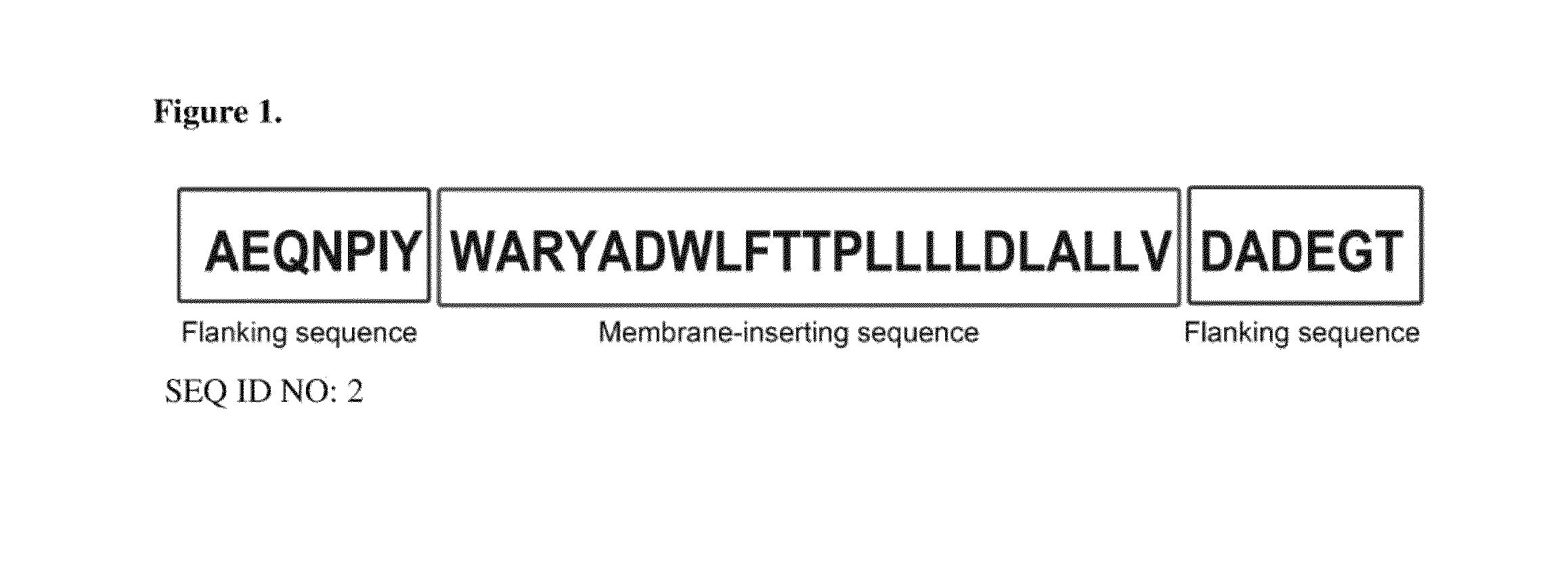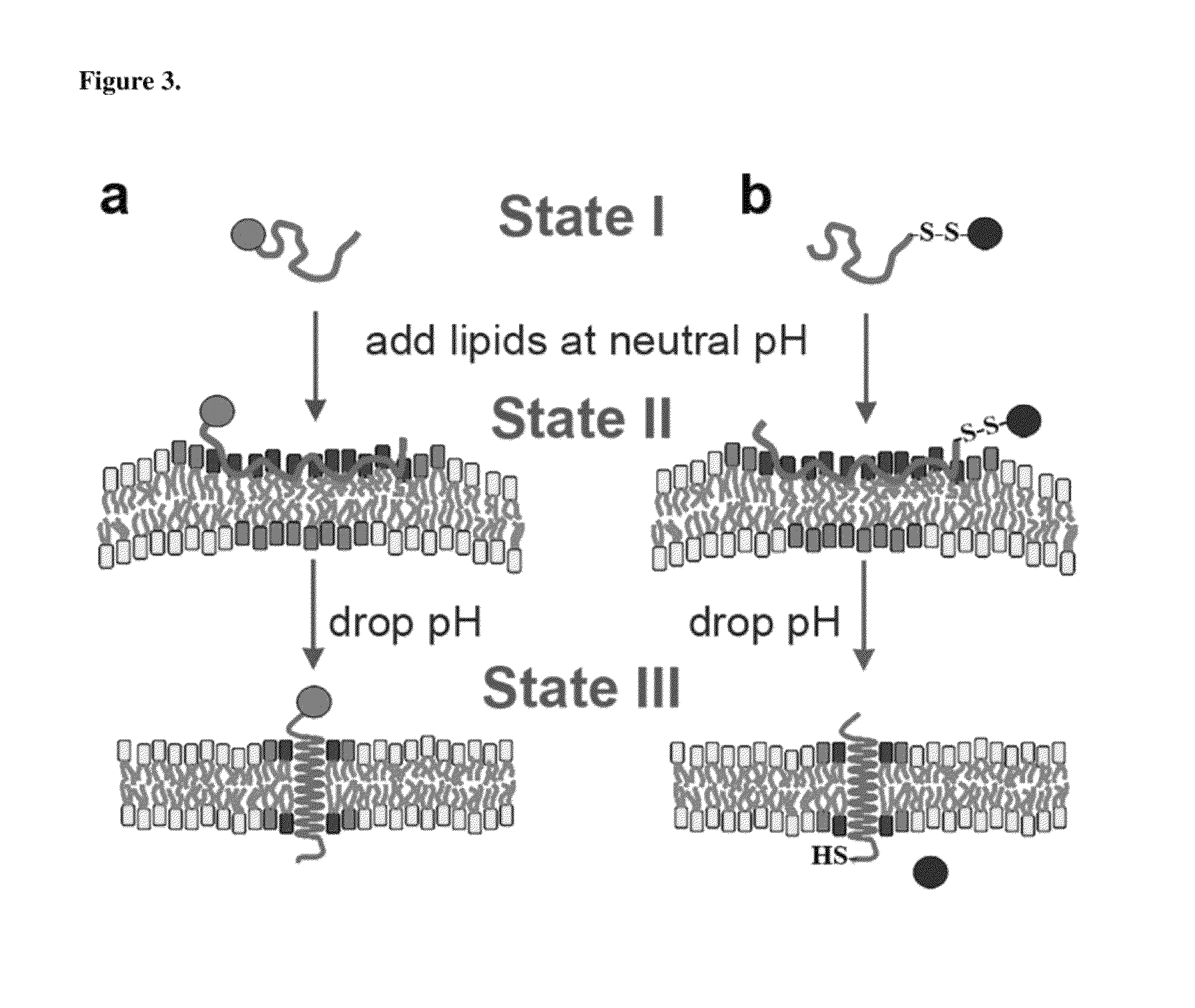Environmentally sensitive compositions and methods of use in the treatment and diagnosis of tumors
a composition and composition technology, applied in the field of environmental sensitive compositions and methods of use in the treatment and diagnosis of tumors, can solve the problems of difficult to rely on any single tumor biomarker, difficult to identify and treat cancer cells while sparing non-cancerous cells, and heterogeneity of human cancers, so as to improve the insertion kinetics and solubility. , the effect of affecting the performance of the polypeptid
- Summary
- Abstract
- Description
- Claims
- Application Information
AI Technical Summary
Benefits of technology
Problems solved by technology
Method used
Image
Examples
example 1
Measuring Tumor Aggressiveness and Targeting Metastatic Lesions with Fluorescent pHLIP
[0145]Malignant cancers exhibit an elevated uptake of glucose that leads to tumor acidosis from the Pasteur and Warburg effects. Glucose uptake and acidosis show a positive correlation with a tumor's aggressiveness and metastatic potential. Therefore, extracellular acidity may be a useful biomarker to evaluate the prognosis of tumor development. pHLIP sequences are a water-soluble membrane peptide that inserts and folds across a cellular membrane lipid bilayer in response to low pH. Membrane-associated folding of pHLIP occurs within seconds and is accompanied by a release of energy (about 2 kcal / mol) that can be used to target acidic tumors in vivo and move cell-impermeable cargo-molecules across cellular membranes. The extent of tumor labeling, measured by conjugating pHLIP with fluorescent and PET imaging agents, is directly related to the level of acidity in tumors of various types. Accumulation...
example 2
Cancer Cell Proliferation is Inhibited by Targeted Intracellular Delivery of Otherwise Membrane-Impermeable Cytotoxins
[0163]Tumor cell proliferation was found to be inhibited by pHLIP-mediated delivery of an exemplary membrane impermeable toxin, phalloidin. The pHLIP construct acts as a nanosyringe that not only injects the cytotoxin into the cell targeted for killing but selectively does so by virtue of its ability to insert only under specific local environmental conditions.
[0164]Phlip peptides insert into a lipid bilayer under slightly acidic conditions (pH 6-6.5), forming a transmembrane helix. pHLIP-mediated translocation of a cell-impermeable, polar toxin phalloidin, inhibits the proliferation of cancer cells in a pH-dependent fashion. The delivery constructs, pHLIP-K(rho)C(aph) and pHLIP-C(aph), both carry the phalloidin toxin at the inserting C-terminus, via a disulfide linkage that is cleaved in cells. The constructs differ in that a lipophilic rhodamine moiety is also atta...
example 3
pHLIP-Assisted Delivery of Amanitin to Cancer Cells
[0207]α-amanitin is a cytotoxin isolated from the Death Cap mushroom Amanita phalloides.
[0208]
It is a cyclic peptide of eight amino acids, is cell impermeable, and acts as an inhibitor of RNA-polymerase II. Constructs are synthesized as follows:
[0209]
[0210]First stage: Conjugation of amanitin with Sulfo-LC-SMPT (activated NHS-ester reacts with the amine group to form amide linkage). Second stage: Conjugations of amanitin-LC-SMPT with pHLIP-C(activated 2-pyridyldithiol group reacts with sulfhydyil group to form a disulfide linkage).
[0211]In another approach, the linker SPDP was used.
[0212]
SPDP is shorter chain cross-linker than SMPT, and as a result it is less hydrophobic. Thus SPDP-amanitin is more polar than SMPT-amanitin. HeLa cells were treated with pHLIP-SPDP-amanitin for 3 h in DMEM w / o FBS at pH 6.2 or 7.4. Constructs were removed, and Hela cells were incubated in standard medium for 24 h. MTS test was done. With SPDP as a lin...
PUM
| Property | Measurement | Unit |
|---|---|---|
| pH | aaaaa | aaaaa |
| radioactive | aaaaa | aaaaa |
| fluorescent | aaaaa | aaaaa |
Abstract
Description
Claims
Application Information
 Login to View More
Login to View More - R&D
- Intellectual Property
- Life Sciences
- Materials
- Tech Scout
- Unparalleled Data Quality
- Higher Quality Content
- 60% Fewer Hallucinations
Browse by: Latest US Patents, China's latest patents, Technical Efficacy Thesaurus, Application Domain, Technology Topic, Popular Technical Reports.
© 2025 PatSnap. All rights reserved.Legal|Privacy policy|Modern Slavery Act Transparency Statement|Sitemap|About US| Contact US: help@patsnap.com



